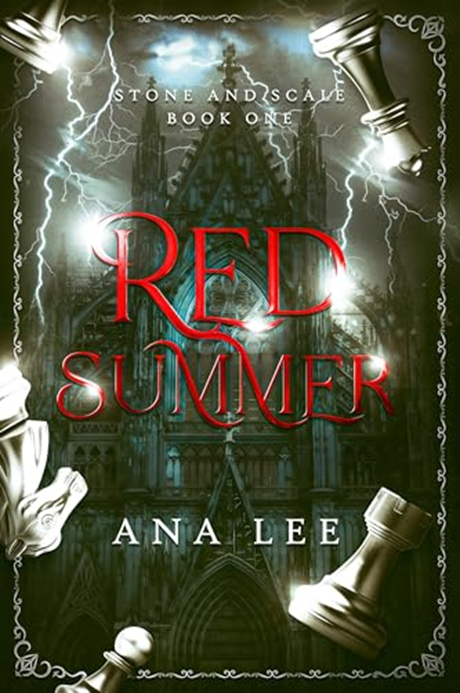“The voice was the poison, and the poison was the voice, and it all wrapped around him in the dense fog.”
Synopsis
The past seventeen years haven’t exactly been stable for Wilder. Sure, most kids going through the foster system have their fair share of difficulties, but those don’t usually include accidental arson caused by a flame produced from nothing. Strange things have been happening to Wilder — things he would rather pretend don’t exist. During a freak lightning storm, he finds himself thrown into the company of people who don’t consider this strange at all, but normal. As he discovers a hidden world behind the Shroud, Wilder must enter the Eadar and uncover the truth about who he is, all while learning to master his abilities before they master him.
If this imaginative fantasy interests you and you’d like to support a new indie author, find it here:
Worldbuilding
At first, the worldbuilding in Red Summer may seem a little overwhelming, but fear not, as there’s a really helpful glossary of key people, places, and species. Ana Lee draws clear inspiration from the world of Cassandra Clare’s Mortal Instruments series, most notably through the gothic architecture of the Council House, and the exploration of fae, werewolves, vampires and spellcasters. However, that’s not to imply Red Summer is a cheap imitation. Lee adds fresh perspectives on these staple fantasy characters through political dynamics amidst a war, and the introduction of the mysterious dragonstones. Aspects of the latter are only beginning to unfold by the end of this book, creating a feeling of intrigue about their significance, making Red Summer a great first installment in the series.
Mood
What stood out to me about Lee’s writing was her ability to juggle multiple moods within a scene. Reminiscent of some of my favourite authors such as Leigh Bardugo, Lee balances the tension of a coming-of-age narrative set in a dangerous realm with the comedic camaraderie within the found family. Whilst we mainly follow our protagonist, Wilder, through a third-person perspective, we’re occasionally treated to the viewpoints of other characters. These moments allow for deeper emotional insight into their backstories, particularly that of resident lycan, Olivia. The use of flashbacks to explore her childhood stood out to me.
“Fearing the day when the moon would call to her again, the girl watched in terror every night, its freckled white face looming larger and larger.”
As for Wilder, he’s a likeable character, a strong underdog to root for. His determination is endearing, and it’s heart-warming to see him find somewhere he finally feels like he belongs, and something worth fighting for.
“Hope blossomed from the echoes of that longing, the first blooms of spring after the last snowfall of winter.”
Description
I really enjoyed the way Lee describes the natural world and the way the characters — particularly the fae interact and perceive it. I look forward to seeing how the magical land of Teír will be portrayed in future installments, as I can only imagine the detail Lee’s words will conjure.
The use of colour imagery in connection with magic was evocative and expressive, exemplified by this description of faerie wings protruding:
“Swaths of his skin brightened into a luminous white light, flaring with incandescence as they peeled themselves from the folds of his body.”
Romance
Whilst not a romantasy book, the romantic subplots in this book were carefully curated throughout. Lee teases readers with a slow-burn romance that carries just the right amount of chemistry to satisfy, without providing a neat conclusion. I look forward to seeing how these relationships develop as the characters continue to navigate the feelings they’re suppressing. There are multiple dynamics at play here, including friends-to-lovers, forbidden attraction, and a subtle love triangle.
Morality
The power struggle between light and dark is a key theme in Red Summer, and I expect it will only become more prominent in future books. Lee includes snippets into the past and the political history of the Eadar. There are also interesting discussions of faith in the context of the Magíck, where Lee’s inspiration from the likes of C.S. Lewis becomes evident.
Darker themes of abuse, neglect, and death are touched on, and can be expected to be explored further in subsequent books as the main characters age. I am intrigued by the introduction of the character Jeselle, and the ambiguity surrounding both her nature and potential:
“She hath been kissed by opposite sides of the same coin, and that coin remains tossed. Beware of how and when it may land.”
Final Thoughts
Red Summer is a promising debut for a multitude of reasons. Not only for its complexity and compelling characters, but for the fact it stands on its own feet as a fantasy novel in a heavily saturated market. Its tone is reminiscent of the first fantasy series I fell in love with as a teenager, and I am eager to see what Ana Lee has in store for us next.
“The screams of those they had left behind followed them, haunting their path to salvation.”
Have you read this book?
We would love to hear your thoughts on this book, perhaps you agree with our review, or, disagree?





